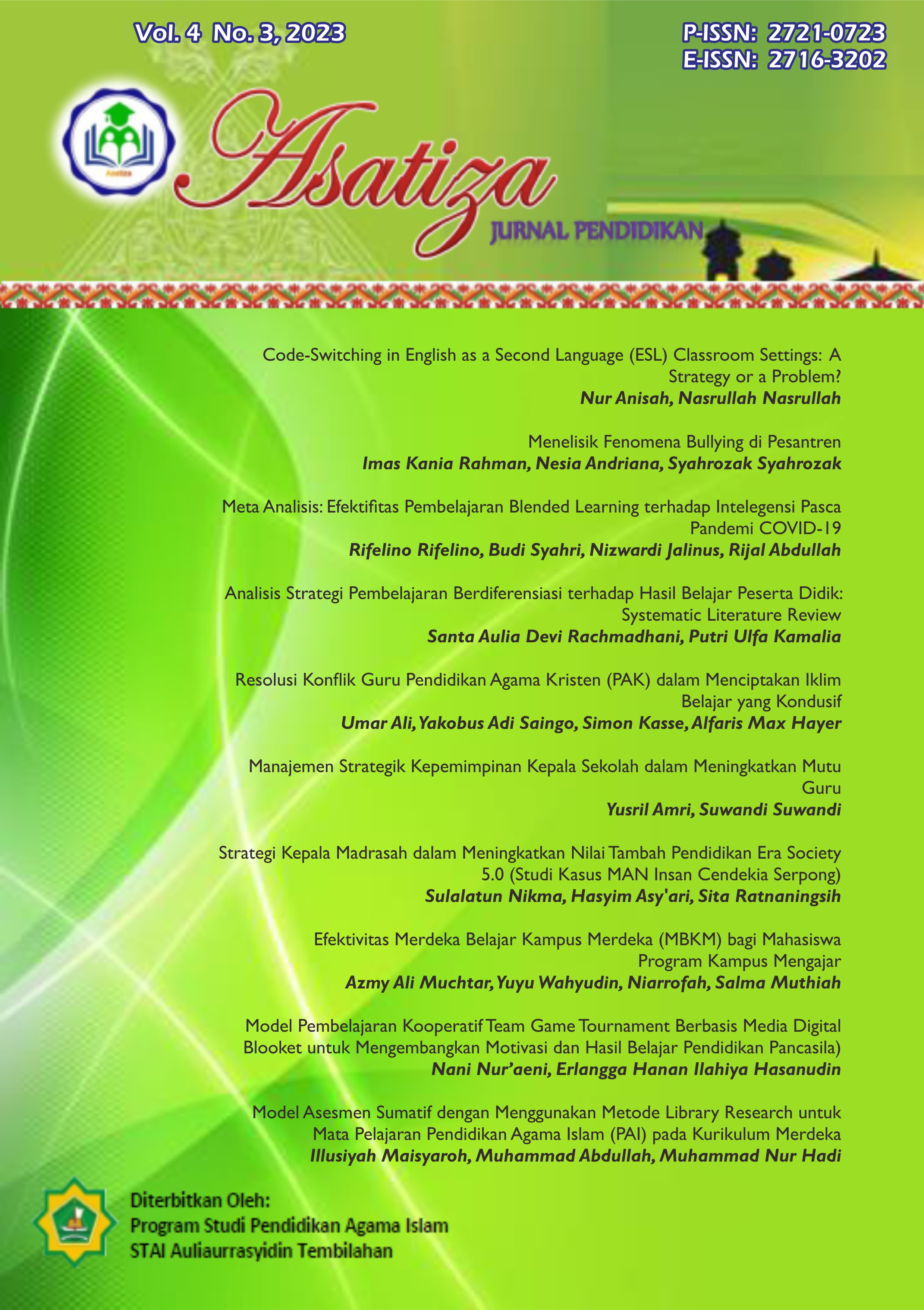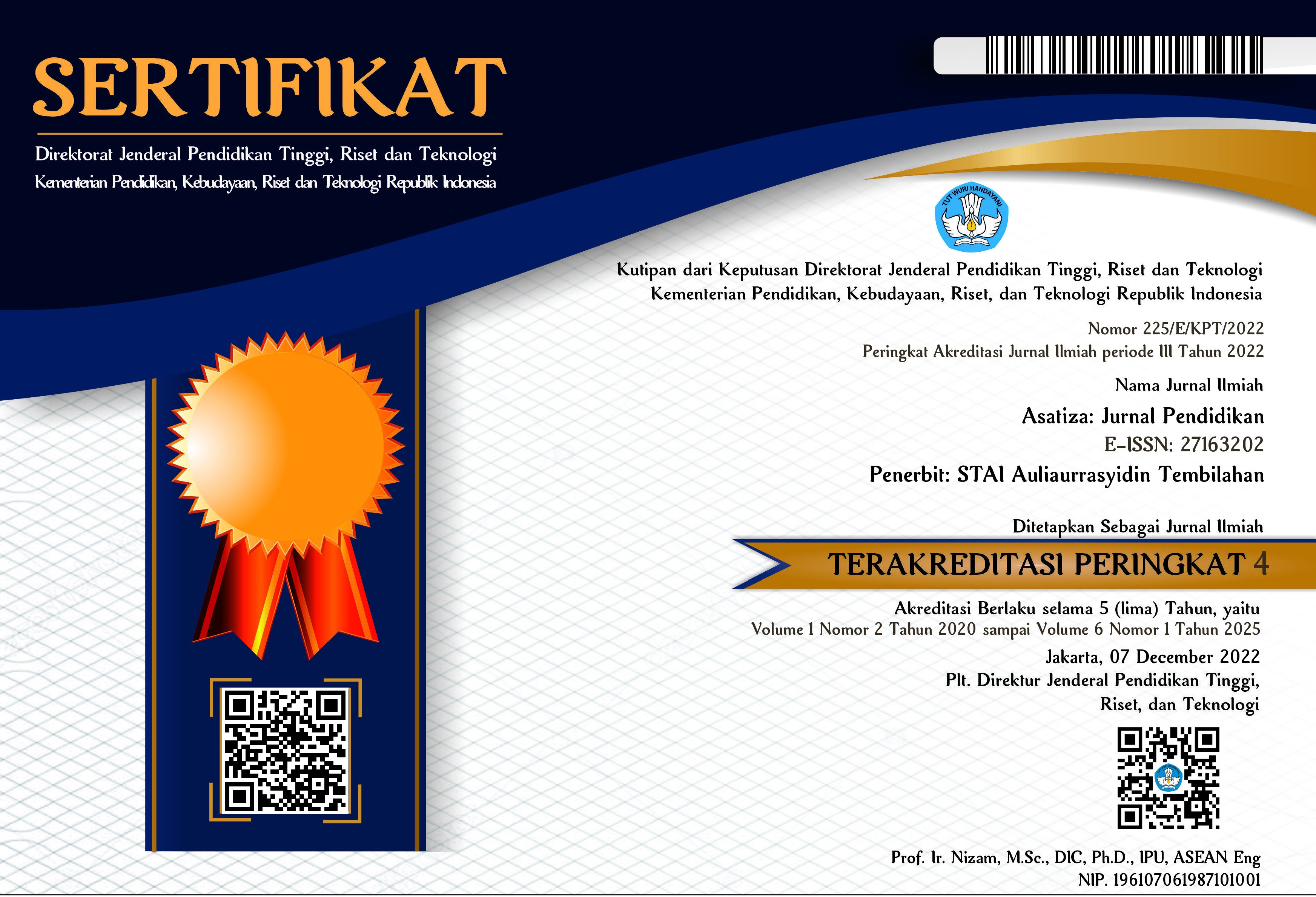Menelisik Fenomena Bullying di Pesantren
DOI:
https://doi.org/10.46963/asatiza.v4i3.1179Keywords:
Bullying, Islamic Bording School, SantriAbstract
Bullying behavior often occurs in Islamic boarding schools. Based on information from the Indonesian Child Protection Commission, bullying is the most common occurrence in school environments. The aim of this study was to describe the bullying phenomenon that occurs in Islamic boarding schools. The study was carried out using a descriptive qualitative approach with data collection methods in the form of document analysis. The findings found that bullying which usually occurs in schools also occurs in Islamic boarding schools. The situation of students living in Islamic boarding schools makes bullying more likely to occur. Bullying in Islamic boarding schools is caused by several factors, namely: lack of companions which has an impact on the effectiveness of controlling student activities, negative social environment and being a role model for other students, senior and junior culture, unclear regulations regarding bullying, and lack of training for students in prevention. and management of Islamic boarding schools. This study recommends the establishment of an anti-bullying program in Islamic boarding schools through increasing the number of supervisors, anti-bullying intervention training for Islamic boarding school supervisors, drafting anti-bullying regulations, adapting and expanding anti-bullying, facilities and planning. anti-bullying curriculum, implementing anti-bullying training for students and making students anti-bullying agents in Islamic boarding schools.
Downloads
References
Algristian, H., As, N. A., Fithriyah, F. K., Khamida, K., Hidayah, N., & Yahya, D. (2022). Pencegahan perundungan untuk mendukung zero violance education di lingkungan pondok pesantren. Prosiding Seminar Nasional Pengabdian Kepada Masyarakat Universitas Nahdlatul Ulama Surabaya, 1(1), 209–217. https://doi.org/10.33086/Snpm.V1i1.809
Alim, A., Sastra, A., & Maulani, M. I. M. (2022). Manajemen pembinaan karakter mulia. Al-Liqo: Jurnal Pendidikan Islam, 7(2), 179–188. https://doi.org/10.46963/Alliqo.V7i2.584
Andrianto, A., Sumiarti, S., Nofitayanti, N., & Hidayatullah, R. (2022). Pembentukan karakter berbasis pendidikan pesantren: studi tentang ragam nilai dan metode pembelajaran. Fitrah: Journal of Islamic Education, 3(2), 176-190. https://doi.org/10.53802/fitrah.v3i2.156
Anggraeni, R. S., & Inten, D. N. (2021). Implikasi pendidikan dari Qs Al-Hujurat Ayat 11 terhadap Pencegahan perilaku bullying. Jurnal Riset Pendidikan Agama Islam, 1–6. https://doi.org/10.29313/jrpai.v1i1.34
Azura, N., & Yudhyarta, D. Y. (2020). Pengaruh pendidikan moral terhadap prilaku siswa pada mata pelajaran pendidikan kewarganegaraan di Madrasah Ibtidaiyah Negeri 1 Indragiri Hilir. Asatiza: Jurnal Pendidikan, 1(2), 151–168. https://doi.org/10.46963/asatiza.v1i2.79
Distina, P. P. (2019). Program anti-bullying sebagai pencegahan dan penanganan perilaku bullying di pesantren. Tawshiyah: Jurnal Sosial Keagaman dan Pendidikan Islam, 14(2). https://doi.org/10.32923/taw.v14i2.1295
Emilda, E. (2022). Bullying di pesantren: Jenis, bentuk, faktor, dan upaya pencegahannya. Sustainable Jurnal Kajian Mutu Pendidikan, 5(2), 198- 207. https://doi.org/10.32923/kjmp.v5i2.2751
Fadilah, N., Ariantini, N., & Ningsih, S. W. (2023). Fenomena bullying di kawasan pondok pesantren. Jurnal Bimbingan dan Konseling Borneo, 5(1), 1-10. https://doi.org/10.35334/jbkb.v5i1.4061
Farhan, F., & Aziah, A. (2019). Upaya wali asuh pada peserta asuh mengatasi bullying di pesantren nurul jadid perspektif komunikasi persuasif. Briliant: Jurnal Riset Dan Konseptual, 4(1), 46-55. https://doi.org/10.28926/briliant.v4i1.265
Firdaus, J., & Aisyah, N. (2020). Revitalisasi nilai-nilai pendidikan agama Islam dalam menanggulangi problematika bullying di pesantren. Jurnal Sains Sosio Humaniora, 4(2), 898-907. https://doi.org/10.22437/jssh.v4i2.11734
Hamidah, M. (2020). Religiusitas Dan Perilaku Bullying Pada Santri Di Pondok Pesantren. Psycho Holistic, 2(1), 141-151.
Hatta, M. (2018). Tindakan Perundungan (bullying) dalam dunia pendidikan ditinjau berdasarkan hukum pidana Islam. Miqot: Jurnal Ilmu-Ilmu Keislaman, 41(2), 280-301 https://doi.org/10.30821/miqot.v41i2.488
Herawati, N., & Deharnita, D. (2019). Gambaran faktor-faktor penyebab terjadinya perilaku bullying pada anak. Ners Jurnal Keperawatan, 15(1), 60-66. https://doi.org/10.25077/njk.15.1.60-66.2019
Laeheem, K. (2013). Factors associated with bullying behavior in islamic private schools, Pattani Province, Southern Thailand. Asian Social Science, 9(13). 55-60 https://doi.org/10.5539/ass.v9n3p55
Muadi, M. (2023). Faktor Risiko perilaku perundungan psikologis pada remaja putri di Pondok Pesantren Ar-Ridwan Kabupaten Cirebon. Blantika: Multidisciplinary Journal, 2(2), 149-155. https://doi.org/10.57096/blantika.v2i2.33
Nashiruddin, A. (2019). Fenomena bullying di pondok pesantren Al-Hikmah Kajen Pati. Quality, 7(2), 81-99. https://doi.org/10.21043/quality.v7i2.6295
Nugroho, S., Handoyo, S., & Hendriani, W. (2020a). Identifikasi faktor penyebab perilaku bullying di Pesantren: Sebuah Studi Kasus. Al-Hikmah: Jurnal Agama dan Ilmu Pengetahuan, 17(2), 1-14. https://doi.org/10.25299/al-hikmah:jaip.2020.vol17(2).5212
Nurhaliza, S., & Siregar, I. S. (2020). Pendidikan Islam multikultural di pondok pesantren Ulumul Qur’an Stabat Kab. Langkat. Fitrah: Journal of Islamic Education, 1(1), 89-106. https://doi.org/10.53802/fitrah.v1i1.10
Prasetyo, A. B. E. (2011). Bullying di sekolah dan dampaknya bagi masa depan anak. El-Tarbawi, 4(1), 19-26. https://doi.org/10.20885/tarbawi.vol4.iss1.art2
Rachmah, D. N. (2016). Empati pada pelaku bullying. Jurnal Ecopsy, 1(2), 51-58. https://doi.org/10.20527/ecopsy.v1i2.487
Salleh, N. M., & Zainal, K. (2014). Bullying among secondary school students in Malaysia: A Case Study. International Education Studies, 7(13), 184–191. https://doi.org/10.5539/ies.v7n13p184
Sari, S. L., & Antasari, W. (2018). Kontribusi Konsep Diri Terhadap Perilaku Bullying. Mitra Ash-Shibyan: Jurnal Pendidikan Dan Konseling, 2(1), 51–64. https://doi.org/10.46963/mash.v2i1.25
Syam, A. R. (2015). Manajemen pendidikan kedisiplinan santri di pondok pesantren: Studi kasus di Pondok Modern Darussalam Gontor [Masters, Universitas Islam Negeri Maulana Malik Ibrahim]. Http://Etheses.Uin-Malang.Ac.Id/3347/
Tim Kpai. (2020). Sejumlah Kasus Bullying Sudah Warnai Catatan Masalah Anak Di Awal 2020. Komisi Perlindungan Anak Indonesia (Kpai). https://www.kpai.go.id/publikasi/sejumlah-kasus-bullying-sudah-warnai-catatan-masalah-anak-di-awal-2020-begini-kata-komisioner-kpai%20diunggal%201%20november%202022
Wijaya, H. (2018). Analisis Data Kualitatif Model Spradley (Etnografi). https://repository.sttjaffray.ac.id/uk/publications/269015/
Yani, A. L., Winarni, I., & Lestari, R. (2016). Eksplorasi fenomena korban bullying pada kesehatan jiwa remaja di pesantren. Journal of Nursing Science Update, 4(2), 99 – 113. https://jik.ub.ac.id/index.php/jik/article/view/98
Yuhbaba, Z. N. (2019). Eksplorasi Perilaku bullying di pesantren. Jurnal Kesehatan Dr. Soebandi, 7(1), 63-71. https://doi.org/10.36858/jkds.v7i1.143
Yuliani, W. (2018). Metode penelitian deskriptif kualitatif dalam perspektif bimbingan dan konseling. Quanta, 2(2), 83-91. https://doi.org/10.22460/q.v2i2p83-91.1641
Zakiyah, E. Z., Humaedi, S., & Santoso, M. B. (2017). Faktor yang mempengaruhi remaja dalam melakukan bullying. Prosiding Penelitian Dan Pengabdian Kepada Masyarakat, 4(2), 324-330. https://doi.org/10.24198/jppm.v4i2.14352
Downloads
Published
Issue
Section
License
Copyright (c) 2023 Imas Kania Rahman, Nesia Andriana, Syahrozak Syahrozak

This work is licensed under a Creative Commons Attribution-ShareAlike 4.0 International License.
Authors who publish with this journal agree to the following terms:
1. Copyright on any article is retained by the author(s).
2. The author grants the journal, right of first publication with the work simultaneously licensed under a Creative Commons Attribution shareAlike 4.0 International License that allows others to share the work with an acknowledgment of the work’s authorship and initial publication in this journal.
3. Authors are able to enter into separate, additional contractual arrangements for the non-exclusive distribution of the journal’s published version of the work (e.g., post it to an institutional repository or publish it in a book), with an acknowledgment of its initial publication in this journal.
4. Authors are permitted and encouraged to post their work online (e.g., in institutional repositories or on their website) prior to and during the submission process, as it can lead to productive exchanges, as well as earlier and greater citation of published work.
5. The article and any associated published material is distributed under the Creative Commons Attribution-ShareAlike 4.0 International License











2.png)



